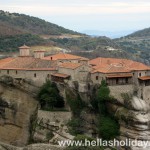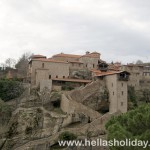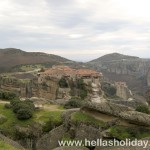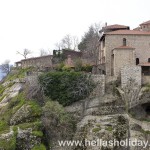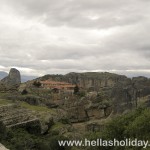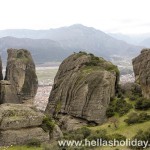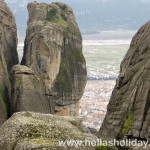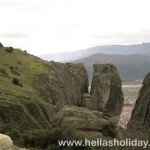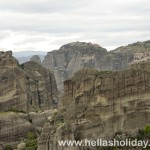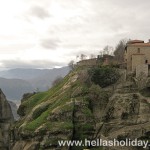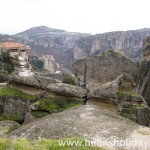Meteora (Greek: Μετέωρα, which translates to “suspended in the air”) is an outstanding complex of giant rock formations near the town of Kalambaka, in the district of Thessaly. The rocks rise over 400 metres above Kalambaka and the valley of river Peneus.
It is still unclear how these rocks were formed, but it is estimated that this happened approximately 60 million years ago. The most prevalent theory about their formation is through a big river that brought geological material, such as rocks, stones and minerals, to the region. Continuous weathering by rain, wind, as well as earthquakes, gave them their present shape. It still remains a mystery, though, why such a unique place is not mentioned anywhere in the Greek mythology and why no Greek or foreign historian has written about it.
Between the 10th century and today 30 monasteries of admirable architecture have been built on these natural sandstone rock pillars, but only six of them remain in a good condition and house religious communities nowadays. For centuries, these monasteries were almost inaccessible, and the monks climbed to the top of Meteora, using rope ladders fixed to the rocks with the aid of wooden poles carefully positioned in rock cracks. The supply of the monasteries was done using nets that hauled up food, water and other necessary goods, as well as people. It was only in the beginning of the 20th century that steps were carved into the rock and facilitated the access to the monasteries. During the World War II, the region of Meteora was bombed and many art treasures were stolen.
There are dozens of activities to do at Meteora or the surrounding region. Rock climbing is of course the most obvious one, but also one absolutely worth trying. The sandstone rocks provide natural grips, which render Meteora the ideal choice for beginners. For those of you falling under this category, the routes found at the rock of Doupiani are probably the best choice, as the difficulty of many of them does not exceed grade IV. All routes have been traditionally established from the base upwards, which may in some cases look surreal, as some of them continue vertically for almost 500 metres. The most difficult ones are Crazy Dance (IX) and Orchidea (grade VIII), followed by Efialtis (grade VIII), Action Direct (grade VIII) and many others.
Meteora is a breathtaking and unique monument of natural and cultural importance, and it is righteously included in UNESCO’s World Heritage List. If you visit this part of Greece, make sure you don’t miss this amazing attraction. Kalambaka, the nearest big town, is an ideal starting point for your excursions to Meteora and to dozens of other great places that are absolutely worth seeing!
- Monastery built at the top of Meteora giant rocks, close view
- Monastery built at the top of Meteora giant rocks
- Monastery built at the top of Meteora giant rocks, close view
- Monastery built at the top of Meteora giant rocks
- Monastery built at the top of Meteora giant rocks, close view
- The town of Kalambaka as seen through Meteora giant rocks
- The town of Kalambaka as seen through Meteora giant rocks, close view
- The town of Kalambaka as seen through Meteora giant rocks
- Monastery built at the top of Meteora giant rocks
- Monastery built at the top of Meteora giant rocks

